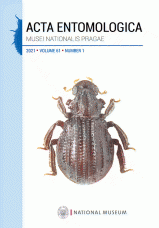The family Epimetopidae (Coleoptera: Hydrophiloidea): review of current knowledge, genus-level phylogeny, and taxonomic revision of Eupotemus
Fikáček Martin, Matsumoto Keita, Perkins Philip, Prokin Alexander, Sazhnev Alexey, Litovkin Stanislav, Jäch Manfred A.
Acta Entomologica Musei Nationalis Pragae 61(1): 1-34, 2021
Published online: 3rd February 2021
Views: 4053
Abstract: Epimetopidae are a small beetle family of the superfamily Hydrophiloidea,
comprising 72 described species in three genera: the American Epimetopus
Lacordaire, 1854 (56 species), Asian Eumetopus Balfour-Browne, 1949 (eight
species) and African Eupotemus Ji & Jäch, 1998 (eight species, of which six
are described as new here). In this study we illustrate and compare the adult
morphology of all three genera and generate the first DNA sequences for
Eumetopus and Eupotemus. The morphological data and sequences of four genes
(cox1, 16S, 18S and 28S) are used to reconstruct phylogenetic relationships
among genera. Both strongly support the monophyly of Epimetopidae, reveal
Eumetopus as the earliest diverging taxon and Epimetopus + Eupotemus as a
strongly supported clade with numerous synapomorphies. The reciprocal monophyly
of Epimetopus and Eupotemus is strongly supported by DNA data but not in the
morphological analysis which reveals Epimetopus paraphyletic. Eumetopus, despite
being the earliest branching clade, is characterized by many unique derived
structures, e.g. by the presence of the sperm pump in males (unique in
Hydrophiloidea). The available data on the biology of Epimetopidae indicate that
most species inhabit sandy to muddy margins of streams or rivers. Females of all
three genera carry egg cases; Epimetopidae hence are one of three independent
lineages of Hydrophiloidea in which this behavior evolved. Larvae are only known
for Epimetopus and are characterized by morphological adaptations for feeding by
piercing and sucking, a closed tracheal system and abdominal gills; larvae of
Eumetopus and Eupotemus remain unknown and further research is needed to confirm
whether they show the same adaptations as Epimetopus. The taxonomy of the
African genus Eupotemus is revised, with six species described as new: E.
bilobatus sp. nov. (Nigeria), E. cameroonensis sp. nov. (Cameroon), E.
ophioglossus sp. nov. (Gabon, Togo), E. smithi sp. nov. (Côte d’Ivoire), E.
taianus sp. nov. (Côte d’Ivoire) and E. uluguru sp. nov. (Tanzania).
Eupotemus limicola Delève, 1967 is fixed as the type species of the genus
according to ICZN (1999: Art. 70.3). New records of Eumetopus species are
provided (E. acutimontis Ji & Jäch, 1998 from Vietnam, E. bullatus (Sharp,
1875) from India: Maharashtra, E. flavidulus (Sharp, 1890) from India:
Maharashtra and Andhra Pradesh, E. maindroni (Régimbart, 1903) from India:
Maharashtra and Gujarat, and E. weigeli Skale & Jäch, 2003 from India:
Uttarakhand). The habitus of all species is illustrated. An updated checklist of
the Epimetopus species is provided, and records of two specimens of the E.
costatus group from Zambia and Saudi Arabia are considered to result from either
accidental introductions or mislabelling.
Key words: Coleoptera, Hydrophiloidea, Epimetopidae, Georissidae, biology, DNA, morphology, new records, new species, phylogeny, revision, systematics, type species, Africa, Asia
Published PDF
Supplementary
Papers
The family Epimetopidae (Coleoptera: Hydrophiloidea): review of current knowledge, genus-level phylogeny, and taxonomic revision of EupotemusEight new species and additional records of the Pselaphodes complex from Laos and Vietnam, with a key to known species (Coleoptera: Staphylinidae: Pselaphinae)Nomenclatural and taxonomic notes on some species of Gyrinidae (Coleoptera)Stenocephus janseni sp. nov., a new species of stem-sawfly from Germany (Hymenoptera: Cephidae)Neurostigma (Psocodea: Psocomorpha: Epipsocidae) from Colombia: new species and an identification keyA review of the genus Rhyparus in the Philippines, with descriptions of two new species from Mindanao (Coleoptera: Scarabaeidae: Aphodiinae)Review of the genus Cavelerius (Heteroptera: Blissidae) with descriptions of three new species from China and Southeast AsiaRevision of the genus Exosehirus (Heteroptera: Cydnidae), with the description of two new speciesRevision of the intertidal rove beetle genus Bryothinusa from Japan (Coleoptera: Staphylinidae: Aleocharinae)Neopanorpa (Mecoptera: Panorpidae) from the Himalayas and adjacent regions, with descriptions of three new speciesFirst records of the North American leafhopper Gyponana mali (Hemiptera: Cicadellidae) invading urban gardens and agroecosystems in EuropeThe genus Xenobates (Hemiptera: Veliidae) in the Philippines: overview and description of two new speciesReview of Indian Closterocerus (Hymenoptera: Chalcidoidea: Eulophidae), with description of two new speciesA review of the New Zealand Berosus (Coleoptera: Hydrophilidae) with descriptions of three new speciesDifferentiation of South African coastal rock pool Ochthebius is associated with major ocean currents (Coleoptera: Hydraenidae)New species and records of Anthomyzidae (Diptera) from the East Palaearctic, with a checklist of taxa occurring in the areaDescription of fifteen new species of the Hypoxys balteatus species group (Hemiptera: Heteroptera: Pentatomidae)Taxonomic notes on the genus Ischnobaena (Hemiptera: Heteroptera: Reduviidae)Tarehylava, a new planthopper genus from Madagascar (Hemiptera: Fulgoromorpha: Ricaniidae) 